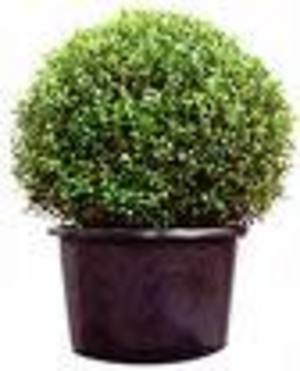Growing a shrub in a container will add variety and uniqueness to the design of your garden or porch. Shrubs can be displayed indoors or outside. Shrubs can be planted at any time, but will establish more quickly if planted during Autumn or Spring.
You will need:
A Shrub
Container
Gravel, or Terracotta crocks
Compost (Loam-based)
Slow release fertilizer, or water retaining crystals
Container Selection
Your container should be large enough to allow the roots to grow. You will also want a container that is heavy and sturdy enough to provide stability to balance the weight of the shrub as it grows. Shrubs tend to be top-heavy, so choose a container to support this weight. Make sure the container has good drainage holes.
If you plan to leave your shrub outside, you will want to invest in a container that can withstand extreme temperatures. Account for the possibility of overheating during the summer, or freezing during the winter. If you live in an area that has extremely cold winters, but plan to keep your shrub outside year round, you will need to provide winter protection. This protection is made by wrapping your container with an insulating layer of burlap. If possible, shelter your plant on the porch or in a cold greenhouse to avoid freezing.
Buying a Shrub
Buy plants with green, healthy foliage. Avoid any with discolored, dead, or damaged leaves. When purchasing a shrub, squeeze the pot to test whether the plant is easily removed from its container. The compost should be moist and stay together when you remove the root ball from the container. The roots shouldn’t grow out of the base of the container.
Prepare the Container
To prepare the container, cover the base of the container with a layer of broken terracotta crocks. The layer should be about three inches thick. Broken pieces of terracotta crocks are placed in the bottom of the container to prevent water logging. One alternative to using crocks, is to use polystyrene pieces. Polystyrene plant trays are a good alternative, and they will keep down the weight of the pot making it easier to move when finished. Then add a layer of compost and a layer of gravel, for extra drainage. Add enough compost to fill the container half full. When purchasing compost for shrubs, you will want to buy a loam-based compost. Loam-based compost is most suitable for shrubs based on its ability to retain nutrients.
If you choose to implement slow release fertilizer or water retaining crystals, add them at this point. These materials will provide added nourishment for your shrub.
Begin Planting
To begin to plant your shrub, you will need to remove it from its original container. When doing so, place the pot on its side, and gently squeeze the pot. The shrub, with its root ball, will easily come out of the container. Tease the roots at the base of the plant to prepare the plant for its new pot. Place the shrub in the center of the container and add more compost around the shrub for stability. Use your hands to tamp the compost down around the shrub. Once you have filled the container with compost around your shrub, and have firmed up the soil with your fingers, the soil should be one inch below the rim of the container.
Water your shrub in the container after it has been planted to help settle the water and soil around the roots of the plant. Shrubs have large roots systems which require a generous amount of water. The compost should always be kept slightly moist, so be sure to check the container regularly and water when necessary. Shrubs will likely need to be watered even after a heavy rain.
Container shrubs provide texture, color, and variety to your landscape. Enjoy this gardening experience!
